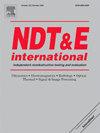Research on rubber inclusion defect detection based on terahertz time-domain spectroscopy technology and image fusion
IF 4.1
2区 材料科学
Q1 MATERIALS SCIENCE, CHARACTERIZATION & TESTING
引用次数: 0
Abstract
Rubber, in the process of production and service, may contain foreign objects, such as fragments and films. These inclusions can lead to increased wear of rubber products during actual use, resulting in unpredictable safety risks. Therefore, it is essential to perform non-destructive testing to ensure the quality of rubber products. In this paper, a high-precision and non-destructive detection method for rubber inclusion defects based on terahertz technology is proposed. The terahertz time-domain spectroscopy was used to detect prefabricated Silicone Rubber samples with metallic inclusion defects. The obtained terahertz spectral data are optimized by using correction processing algorithms and feature extraction methods. And a highly efficient quantitative detection model for internal inclusion defects in Silicone Rubber is established using machine learning algorithms. Firstly, SNV, AirPLS, AsLS and BEADS are individually applied to preprocess the collected time-domain spectra. Secondly, the features of the spectra are extracted by using CARS, UVE and PCA, respectively. Lastly, Partial Least Squares Regression and Least Squares Support Vector Machines are employed to establish quantitative prediction model of the depth of rubber inclusion defects. The experimental results show that the BEADS and CARS algorithms can greatly reduces the computational load of the model while improving its accuracy. The LS-SVM model has the best prediction effect, and the RMSEP and RP of the prediction set are 0.0717 and 0.9964, respectively. In addition, the physics-based model of time-of-flight is also employed to calculate the collected time-domain spectra and predict the defect depth, and the RMSEP and RP of the prediction set are 0.1080 and 0.9986. In terms of terahertz imaging, this paper proposes a high-quality visualization processing scheme for internal inclusion defects in rubber. It utilizes various feature parameters for imaging and employs a combination of grayscale histogram equalization and wavelet transform image fusion methods to achieve high-quality imaging representation of internal inclusion defects in rubber. The THz-TDS techniques enables rapid and non-destructive detection of location, depth and shape of rubber inclusion defect, providing new technological methods for the quality inspection of other polymers.

基于太赫兹时域光谱技术和图像融合的橡胶夹杂物缺陷检测研究
橡胶在生产和服务过程中,可能含有碎片、薄膜等异物。这些夹杂物会导致橡胶制品在实际使用过程中磨损增加,产生不可预测的安全隐患。因此,进行无损检测以保证橡胶制品的质量是必不可少的。提出了一种基于太赫兹技术的橡胶夹杂物缺陷高精度无损检测方法。采用太赫兹时域光谱技术对含金属夹杂缺陷的预制硅橡胶样品进行了检测。利用校正处理算法和特征提取方法对得到的太赫兹光谱数据进行了优化。并利用机器学习算法建立了硅橡胶内部夹杂物缺陷的高效定量检测模型。首先,分别应用SNV、AirPLS、AsLS和BEADS对采集的时域光谱进行预处理。其次,分别利用CARS、UVE和PCA提取光谱特征;最后,利用偏最小二乘回归和最小二乘支持向量机建立了橡胶夹杂物缺陷深度的定量预测模型。实验结果表明,珠子和CARS算法在提高模型精度的同时,大大减少了模型的计算量。LS-SVM模型预测效果最好,预测集的RMSEP和RP分别为0.0717和0.9964。此外,还利用基于物理的飞行时间模型对采集的时域谱进行了计算,并对缺陷深度进行了预测,预测集的RMSEP和RP分别为0.1080和0.9986。基于太赫兹成像技术,提出了一种高质量的橡胶内部夹杂物缺陷可视化处理方案。利用各种特征参数进行成像,结合灰度直方图均衡化和小波变换图像融合方法,实现橡胶内部夹杂物缺陷的高质量成像表示。THz-TDS技术能够快速、无损地检测橡胶夹杂物缺陷的位置、深度和形状,为其他聚合物的质量检测提供了新的技术方法。
本文章由计算机程序翻译,如有差异,请以英文原文为准。
求助全文
约1分钟内获得全文
求助全文
来源期刊

Ndt & E International
工程技术-材料科学:表征与测试
CiteScore
7.20
自引率
9.50%
发文量
121
审稿时长
55 days
期刊介绍:
NDT&E international publishes peer-reviewed results of original research and development in all categories of the fields of nondestructive testing and evaluation including ultrasonics, electromagnetics, radiography, optical and thermal methods. In addition to traditional NDE topics, the emerging technology area of inspection of civil structures and materials is also emphasized. The journal publishes original papers on research and development of new inspection techniques and methods, as well as on novel and innovative applications of established methods. Papers on NDE sensors and their applications both for inspection and process control, as well as papers describing novel NDE systems for structural health monitoring and their performance in industrial settings are also considered. Other regular features include international news, new equipment and a calendar of forthcoming worldwide meetings. This journal is listed in Current Contents.
 求助内容:
求助内容: 应助结果提醒方式:
应助结果提醒方式:


